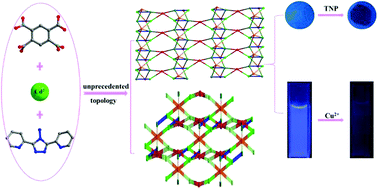Two mixed-ligand Cd(ii)–organic frameworks with unique topologies: selective luminescence sensing of TNP and Cu2+ ions with recyclable performances†
Abstract
Two novel luminescent Cd(II)–organic frameworks, [Cd2(2-abpt)(Hbtca)(H2btca)0.5(H2O)]n (1) and {[Cd3(2-abpt)(btca)1.5]·H2O}n (2) (2-abpt = 3,5-di(2 -pyridyl)-4-amino-1,2,4-triazole, H4btca = 1,2,4,5-benzenetetracarboxylic acid), were hydrothermally synthesized from a rigid aromatic carboxylate ligand and a pyridine ligand containing free amino groups. 1 exhibits a novel (4,4,5,5)-c 2D layer architecture with 1D pipe-like chains. 2 shows a 3D framework with an unprecedented (4,4,4,6,7)-c topology. Their structural differences mainly stem from the various coordination modes of the rigid aromatic carboxylate ligand. Luminescence sensing experiments exhibit that 1 can highly sensitively and selectively detect TNP in DMF and H2O. Moreover, test paper was developed to detect TNP as a convenient and practicable approach. In addition, 1 shows highly sensitive and selective sensing of Cu2+. The possible detection mechanisms of 1 towards TNP and Cu2+ have been discussed. These experimental results suggest that 1 should be a potential sensor for TNP and Cu2+.



 Please wait while we load your content...
Please wait while we load your content...